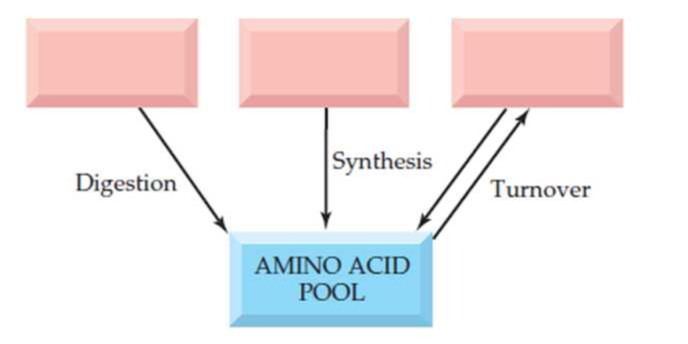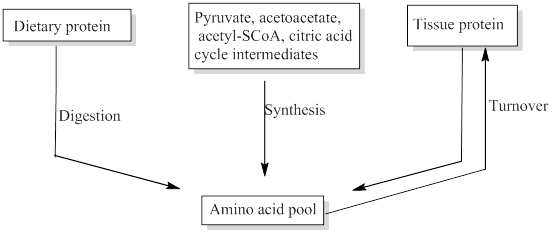
Fundamentals of General, Organic, and Biological Chemistry (8th Edition)
8th Edition
ISBN: 9780134015187
Author: John E. McMurry, David S. Ballantine, Carl A. Hoeger, Virginia E. Peterson
Publisher: PEARSON
expand_more
expand_more
format_list_bulleted
Concept explainers
Textbook Question
Chapter 25, Problem 25.11UKC
In the diagram shown here, fill in the sources for the amino acid pool.

Expert Solution & Answer
Interpretation Introduction
Interpretation:
The missing sources for the amino acids pool has to be filled.
Concept introduction:
- Amino acid had both amino functional group and carboxyl functional group in a molecule.
- Amino acid pool is the entire collection of free amino acids in the whole body.
Explanation of Solution
Free amino acids are present throughout the body, in cells and the extracellular fluids. This pool is supplied by few sources include,
- Non-protein nitrogen compounds
- Dietary protein
- Tissue protein etc.

Conclusion
The missing sources for the amino acids pool was filled.
Want to see more full solutions like this?
Subscribe now to access step-by-step solutions to millions of textbook problems written by subject matter experts!
Students have asked these similar questions
Please help determine the Relative Response Ratio of my GC-MS laboratory:
Laboratory: Alcohol Content in Hand Sanditizers
Internal Standard: Butanol
Standards of Alcohols: Methanol, Ethanol, Isopropyl, n-Propanol, Butanol
Recorded Retention Times: 0.645, 0.692, 0.737, 0.853, 0.977
Formula: [ (Aanalyte / Canalyte) / (AIS / CIS) ]
Please help determine the Relative Response Ratio of my GC-MS laboratory:
Laboratory: Alcohol Content in Hand Sanditizers
Internal Standard: Butanol
Standards of Alcohols: Methanol, Ethanol, Isopropyl, n-Propanol, Butanol
Recorded Retention Times: 0.645, 0.692, 0.737, 0.853, 0.977
Formula: [ (Aanalyte / Canalyte) / (AIS / CIS) ]
please draw it for me and tell me where i need to modify the structure
Chapter 25 Solutions
Fundamentals of General, Organic, and Biological Chemistry (8th Edition)
Ch. 25.2 - Prob. 25.1PCh. 25.2 - Prob. 25.2KCPCh. 25.3 - Prob. 25.3PCh. 25.3 - Prob. 25.4PCh. 25.3 - Prob. 25.5PCh. 25.3 - Prob. 25.6PCh. 25.4 - Prob. 25.1CIAPCh. 25.4 - Prob. 25.2CIAPCh. 25.4 - Prob. 25.3CIAPCh. 25.4 - Prob. 25.7P
Ch. 25.4 - Prob. 25.8KCPCh. 25.6 - Prob. 25.9PCh. 25.6 - Prob. 25.10KCPCh. 25.6 - What is meant by a conditional amino acid?Ch. 25.6 - Prob. 25.5CIAPCh. 25.6 - Prob. 25.6CIAPCh. 25 - In the diagram shown here, fill in the sources for...Ch. 25 - Prob. 25.12UKCCh. 25 - Prob. 25.13UKCCh. 25 - Prob. 25.14UKCCh. 25 - Prob. 25.15UKCCh. 25 - Prob. 25.16UKCCh. 25 - Prob. 25.17APCh. 25 - Prob. 25.18APCh. 25 - Prob. 25.19APCh. 25 - Prob. 25.20APCh. 25 - Prob. 25.21APCh. 25 - Prob. 25.22APCh. 25 - What is the structure of the -keto acid formed...Ch. 25 - Prob. 25.24APCh. 25 - In general, how does oxidative deamination differ...Ch. 25 - Prob. 25.26APCh. 25 - Prob. 25.27APCh. 25 - Prob. 25.28APCh. 25 - Prob. 25.29APCh. 25 - Prob. 25.30APCh. 25 - Prob. 25.31APCh. 25 - Prob. 25.32APCh. 25 - Prob. 25.33APCh. 25 - Prob. 25.34APCh. 25 - How do essential and nonessential amino acids...Ch. 25 - Prob. 25.36APCh. 25 - Prob. 25.37APCh. 25 - How is tyrosine biosynthesized in the body? What...Ch. 25 - Prob. 25.39APCh. 25 - Prob. 25.40APCh. 25 - Prob. 25.41APCh. 25 - What energy source is used in the formation of...Ch. 25 - Write the equation for the transamination reaction...Ch. 25 - Prob. 25.44CPCh. 25 - Prob. 25.45CPCh. 25 - Prob. 25.46CPCh. 25 - Prob. 25.47CPCh. 25 - Prob. 25.48CPCh. 25 - Prob. 25.49CPCh. 25 - Prob. 25.50CPCh. 25 - Prob. 25.51CPCh. 25 - Prob. 25.52CPCh. 25 - Why might it be a bad idea to take large...Ch. 25 - Prob. 25.54GPCh. 25 - Prob. 25.55GPCh. 25 - Prob. 25.56GP
Additional Science Textbook Solutions
Find more solutions based on key concepts
Give the IUPAC name for each compound.
Organic Chemistry
What process causes the Mediterranean intermediate Water MIW to become more dense than water in the adjacent At...
Applications and Investigations in Earth Science (9th Edition)
Why do scientists think that all forms of life on earth have a common origin?
Genetics: From Genes to Genomes
Separate the list P,F,V,,T,a,m,L,t, and V into intensive properties, extensive properties, and nonproperties.
Fundamentals Of Thermodynamics
Identify each of the following reproductive barriers as prezygotic or postzygotic. a. One lilac species lives o...
Campbell Essential Biology with Physiology (5th Edition)
Knowledge Booster
Learn more about
Need a deep-dive on the concept behind this application? Look no further. Learn more about this topic, biochemistry and related others by exploring similar questions and additional content below.Similar questions
- Please help determine the standard curve for my Kinase Activity in Excel Spreadsheet. Link: https://mnscu-my.sharepoint.com/personal/vi2163ss_go_minnstate_edu/_layouts/15/Doc.aspx?sourcedoc=%7B958f5aee-aabd-45d7-9f7e-380002892ee0%7D&action=default&slrid=9b178ea1-b025-8000-6e3f-1cbfb0aaef90&originalPath=aHR0cHM6Ly9tbnNjdS1teS5zaGFyZXBvaW50LmNvbS86eDovZy9wZXJzb25hbC92aTIxNjNzc19nb19taW5uc3RhdGVfZWR1L0VlNWFqNVc5cXRkRm4zNDRBQUtKTHVBQldtcEtWSUdNVmtJMkoxQzl3dmtPVlE_cnRpbWU9eEE2X291ZHIzVWc&CID=e2126631-9922-4cc5-b5d3-54c7007a756f&_SRM=0:G:93 Determine the amount of VRK1 is present 1. Average the data and calculate the mean absorbance for each concentration/dilution (Please over look for Corrections) 2. Blank Correction à Subtract 0 ug/mL blank absorbance from all readings (Please over look for Corrections) 3. Plot the Standard Curve (Please over look for Corrections) 4. Convert VRK1 concentration from ug/mL to g/L 5. Use the molar mass of VRK1 to convert to M and uM…arrow_forwardMacmillan Learning Cholesterol synthesis begins with the formation of mevalonate from acetyl CoA. This process activates mevalonate and converts it to isopentenyl pyrophosphate. Identify the atoms in mevalonate and isopentenyl pyrophosphate that will be labeled from acetyl CoA labeled with 14C in the carbonyl carbon. Place 14C atoms and C atoms to denote which carbon atoms are labeled and which are not labeled. H₂C COA 14C-labeled acetyl-CoA HHH [c] H H OH 014C - OH H HH H Mevalonate CH3 H H 14C H Η H H Incorrect Answer of o -P-O-P-0- Isopentenyl pyrophosphate с Answer Bank 14Carrow_forwardDraw the reaction between sphingosine and arachidonic acid. Draw out the full structures.arrow_forward
- Draw both cis and trans oleic acid. Explain why cis-oleic acid has a melting point of 13.4°C and trans-oleic acid has a melting point of 44.5°C.arrow_forwardDraw the full structure of the mixed triacylglycerol formed by the reaction of glycerol and the fatty acids arachidic, lauric and trans-palmitoleic. Draw the line structure.arrow_forwardDraw out the structure for lycopene and label each isoprene unit. "Where is lycopene found in nature and what health benefits does it provide?arrow_forward
- What does it mean to be an essential fatty acid? What are the essential fatty acids?arrow_forwardCompare and contrast primary and secondary active transport mechanisms in terms of energy utilisation and efficiency. Provide examples of each and discuss their physiological significance in maintaining ionic balance and nutrient uptake. Rubric Understanding the key concepts (clearly and accurately explains primary and secondary active transport mechanisms, showing a deep understanding of their roles) Energy utilisation analysis ( thoroughly compares energy utilisation in primary and secondary transport with specific and relevant examples Efficiency discussion Use of examples (provides relevant and accurate examples (e.g sodium potassium pump, SGLT1) with clear links to physiological significance. Clarity and structure (presents ideas logically and cohesively with clear organisation and smooth transition between sections)arrow_forward9. Which one of the compounds below is the major organic product obtained from the following reaction sequence, starting with ethyl acetoacetate? 요요. 1. NaOCH2CH3 CH3CH2OH 1. NaOH, H₂O 2. H3O+ 3. A OCH2CH3 2. ethyl acetoacetate ii A 3. H3O+ OH B C D Earrow_forward
- 7. Only one of the following ketones cannot be made via an acetoacetic ester synthesis. Which one is it? Ph کہ A B C D Earrow_forward2. Which one is the major organic product obtained from the following reaction sequence? HO A OH 1. NaOEt, EtOH 1. LiAlH4 EtO OEt 2. H3O+ 2. H3O+ OH B OH OH C -OH HO -OH OH D E .CO₂Etarrow_forwardwhat is a protein that contains a b-sheet and how does the secondary structure contributes to the overall function of the protein.arrow_forward
arrow_back_ios
SEE MORE QUESTIONS
arrow_forward_ios
Recommended textbooks for you
 Human Biology (MindTap Course List)BiologyISBN:9781305112100Author:Cecie Starr, Beverly McMillanPublisher:Cengage Learning
Human Biology (MindTap Course List)BiologyISBN:9781305112100Author:Cecie Starr, Beverly McMillanPublisher:Cengage Learning Human Heredity: Principles and Issues (MindTap Co...BiologyISBN:9781305251052Author:Michael CummingsPublisher:Cengage Learning
Human Heredity: Principles and Issues (MindTap Co...BiologyISBN:9781305251052Author:Michael CummingsPublisher:Cengage Learning Biology (MindTap Course List)BiologyISBN:9781337392938Author:Eldra Solomon, Charles Martin, Diana W. Martin, Linda R. BergPublisher:Cengage Learning
Biology (MindTap Course List)BiologyISBN:9781337392938Author:Eldra Solomon, Charles Martin, Diana W. Martin, Linda R. BergPublisher:Cengage Learning
 Human Physiology: From Cells to Systems (MindTap ...BiologyISBN:9781285866932Author:Lauralee SherwoodPublisher:Cengage Learning
Human Physiology: From Cells to Systems (MindTap ...BiologyISBN:9781285866932Author:Lauralee SherwoodPublisher:Cengage Learning


Human Biology (MindTap Course List)
Biology
ISBN:9781305112100
Author:Cecie Starr, Beverly McMillan
Publisher:Cengage Learning

Human Heredity: Principles and Issues (MindTap Co...
Biology
ISBN:9781305251052
Author:Michael Cummings
Publisher:Cengage Learning

Biology (MindTap Course List)
Biology
ISBN:9781337392938
Author:Eldra Solomon, Charles Martin, Diana W. Martin, Linda R. Berg
Publisher:Cengage Learning


Human Physiology: From Cells to Systems (MindTap ...
Biology
ISBN:9781285866932
Author:Lauralee Sherwood
Publisher:Cengage Learning
The Cell Membrane; Author: The Organic Chemistry Tutor;https://www.youtube.com/watch?v=AsffT7XIXbA;License: Standard youtube license